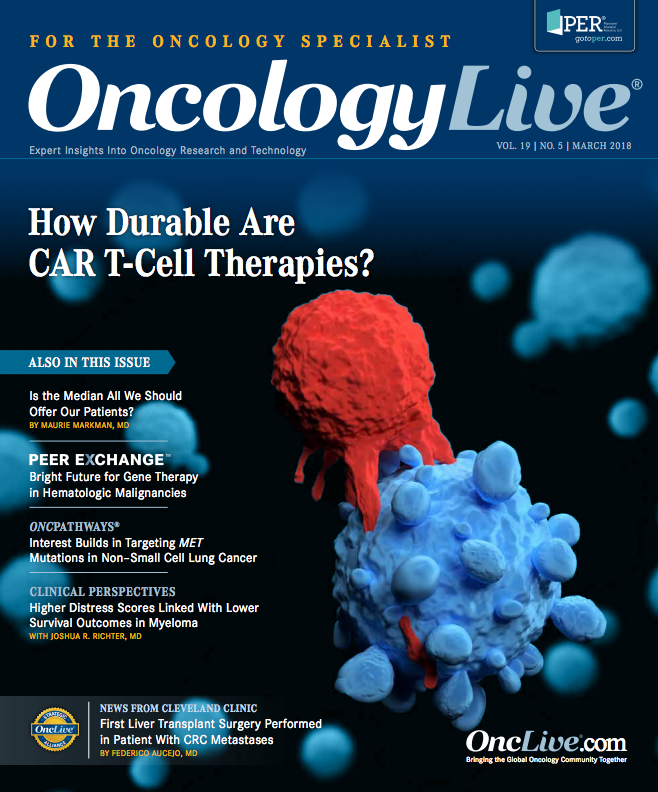Publication
Article
Oncology Live®
Interest Builds in Targeting MET Mutations in Non-Small Cell Lung Cancer
Author(s):
Building on the success of molecularly targeted drugs aimed at relatively small subsets of patients, lung cancer researchers are increasingly aiming at the MET oncogene.
Balazs Halmos, MD, MS.

Balazs Halmos, MD, MS
Although checkpoint blockade immunotherapies have advanced rapidly in the treatment paradigm for patients with non—small cell lung cancer (NSCLC), interest in developing targeted therapies for this malignancy has remained high. Building on the success of molecularly targeted drugs aimed at relatively small subsets of patients, researchers are increasingly aiming at the MET oncogene
During the past several years, interest in MET activity has grown as investigators have considered it both as a biomarker and target for treatment, particularly since the focus on MET exon 14 skipping mutations has led to the development of several second-generation MET inhibitors, according to Balazs Halmos, MD, MS.
MET is a transmembrane receptor tyrosine kinase whose aberrant activity can influence important cell-signaling networks (FIGURE7 ).1 This pathway can be activated in one of several ways, explained Halmos, director of thoracic oncology and director of clinical cancer genomics, Montefiore Medical Center, during a presentation at the 12th Annual New York Lung Cancers Symposium, hosted by Physicians’ Education Resource®, LLC, in December 2017.
Figure 1. MET Signaling Network in Cancer
Search for Correct Biomarker
The pathway can be activated through MET protein overexpression; increased expression of its ligand, hepatocyte growth factor; MET mutations; gene amplification; and alternative splicing or exon 14 skipping. Each of these methods has been investigated as a potential approach to utilize this pathway for the treatment of patients with cancer. “This plethora of possibilities led to a lot of confusion in the field over the years over which biomarker to use for selecting patients for MET-targeted therapy,” Halmos said.Using MET protein overexpression as a biomarker led to the failure of several randomized studies. For example, the phase III METLung trial of onartuzumab (MetMAb) in combination with erlotinib (Tarceva) failed to meet its primary endpoint of improved overall survival (OS) with added onartuzumab in patients with previously treated locally advanced or metastatic NSCLC.
Onartuzumab is a monoclonal antibody that binds to the extracellular domain of MET, yet the combination regimen with onartuzumab demonstrated a median OS of 6.8 months compared with 9.1 months for erlotinib and placebo (HR, 1.27; 95% CI, 0.98-1.65; P = .067).2 The investigators noted that there may be better ways to select patients for MET-targeted therapy than with MET immunohistochemistry.
A greater signal for MET as an actionable target was seen with the use of MET amplification. In the PROFILE 001 study, crizotinib (Xalkori) was investigated in patients with MET—amplified, advanced NSCLC. Although crizotinib is indicated for patients with ALK- or ROS1-rearranged lung cancers, the tyrosine kinase inhibitor (TKI) was originally developed as a type Ia MET inhibitor, Halmos noted. A small trial showed several responses to crizotinib, especially among patients with a higher MET-to-chromosome 7 centromere (MET/CEP7) ratio of ≥5.3
Combinations Explored
“In patients with a very high copy number of MET, suddenly there’s a lack of other critical driver oncogenes being presented; [this] suggested that in those cancers, MET amplification can be the sole clinical driver,” Halmos said. However, he noted that it was difficult for investigators to find the right MET/ CEP7 threshold for identifying patients for such MET-targeted treatment. Although the threshold changes from study to study, the minimum has been set at 5 for high MET amplification.The effect of MET inhibition has also been investigated in combinations as a method of bypassing resistance to treatments. The overall frequency of MET-driven acquired resistance is likely to be about 2% to 5%, Halmos said.
“It seems that the overexpressed MET kinase clusters on the cell surface along with EGFR, and basically creates a complex on the cell surface that leads to an unconventional EGFR signaling not requiring the ATP binding activity of EGFR. As a result, EGFR inhibition on its own is not successful and dual inhibition is necessary.”
An ongoing phase Ib study of savolitinib, a type Ib MET inhibitor, in combination with gefitinib (Iressa) in patients with EGFR-mutated, MET—positive NSCLC who had acquired resistance to a prior EGFR TKI, has demonstrated clinical activity for the combination of dual MET and EGFR inhibition in resistant patients. As of data cutoff, the overall response rate (ORR) was 31% (16/51). Interestingly, the ORR was 52% in patients who were negative for the EGFR T790M resistance mutation and 9% in T790M-positive patients.4
Savolitinib also demonstrated activity in combination with osimertinib (Tagrisso) in the multiarm phase Ib TATTON study in previously treated patients with MET-amplified, EGFRmutant advanced or metastatic NSCLC who progressed after prior EGFR TKI therapy.
In participants previously treated with a T790M-directed therapy, the ORR was 28% (7/25).
Exon 14 Skipping Mutation
In those who progressed after prior treatment with a first- or second-generation EGFR TKI, the ORR was 57% for those with T790M-positive disease and 53% for those with T790M-negative disease.5 In both studies, MET positivity was defined as MET gene copy number ≥5 or MET/CEP7 ratio ≥2, Halmos said.Although a number of mutations of the MET gene can be identified, investigators have found that in patients with NSCLC, most cluster around exon 14 (FIGURE 2), Halmos said.
Figure 2. The MET Proto-Oncogene Is Located in the 7Q31 Locus of Chromosome 7
“When MET exon 14 is skipped…a very specific piece of the MET protein will be missing, and this particular piece contains a critical tyrosine residue. This tyrosine residue is important for CBL binding leading to the degradation of MET,” he explained. Without the tyrosine residue, MET is not degraded appropriately and can remain overactivated and oncogenic.
Overall, this mutation is found in approximately 3% of patients with nonsquamous NSCLC and in 22% of patients with sarcomatoid carcinoma. Among patients with nonsquamous NSCLC and a MET exon 14 skipping mutation, 68% had an adenocarcinoma histology. Additionally, there tended to be an overlap between MET exon 14 skipping alterations and MET amplification in patients with advanced lung cancer.6
“The presence of this specific mutation also marks these cancer cells for great sensitivity against MET-targeted compounds, such as crizotinib, cabozantinib [Cabometyx], and a number of new molecules that are being developed,” Halmos said in an interview with OncologyLive®. “So, finding patients with these MET exon 14 mutations is critical because they can do just as well with the targeted treatment as ALK-, ROS-, and EGFR-mutated patients.”
In a retrospective study of patients with a MET exon 14 skipping mutation, the median OS was 24.6 months for 27 patients with metastatic disease who received at least 1 MET inhibitor compared with 8.1 months in 34 patients who did not receive MET-targeted therapy. Among 22 patients who received crizotinib, the median progression-free survival was 7.36 months.7
Halmos noted, however, that there was some survivor bias in this study. MET exon 14−altered cancers can also express high levels of PD-L1, yet this does not translate into significant clinical benefit with immunotherapies, Halmos said. In a study of patients with recurrent or metastatic NSCLC who harbored a MET exon 14 skipping mutation and who were being treated with checkpoint inhibitors, the ORR from all 63 patients included in the study was 13%. In patients with PD-L1 expression ≥50%, the ORR was 33%, and in patients with no PD-L1 expression, the ORR was 20%.8
“[This] reaffirms that molecular testing doesn’t just help us identify patients for molecular treatment, it helps us understand immunotherapy, as well, outside of tumor mutation burden. So, we need to get this multigene testing for all of our patients if we want to continue to advance the care of our patients,” Halmos said during his presentation.
Table. Clinical Trials for Patients With MET-Mutant NSCLC
Interest in the treatment of patients with MET exon skipping mutations with MET inhibitors has led to the development of newer MET inhibitors, such as capmatinib, tepotinib, and glesatinib, with several others in preclinical stages (TABLE). Several of the agents have multiple molecular targets. Notably, crizotinib is being explored in patients with MET amplification or the exon 14 skipping mutation as part of 2 basket trials, NCI-MATCH (NCT02465060) and the National Lung MATRIX Trial (NCT02664935).
References
- Gelsomino F, Facchinetti F, Haspinger ER, et al. Targeting the MET gene for the treatment of non-smallcell lung cancer. Crit Rev Oncol Hematol. 2014;89(2):284-299. doi: 10.1016/j.critrevonc.2013.11.006.
- Spigel DR, Edelman MJ, O’Byrne K, et al. Results from the phase III randomized trial of onartuzumab plus erlotinib versus erlotinib in previously treated stage IIIB or IV non-small-cell lung cancer: METLung. J Clin Oncol. 2017;35(4):412-420. doi: 10.1200/JCO.2016.69.2160
- Camidge DR, Ou SHI, Shapiro G, et al. Efficacy and safety of crizotinib in patients with advanced c-MET-amplified non-small cell lung cancer (NSCLC). J Clin Oncol. 2014;32(suppl 5s; abstr 8001). meetinglibrary.asco.org/record/92507/abstract.
- Yang JJ, Fang J, Shu Y, et al. A phase Ib trial of savolitinib plus gefitinib for Chinese patients with EGFR-mutant MET-amplified advanced NSCLC. Presented at: 2017 International Association for the Study of Lung Cancer World Conference on Lung Cancer; October 15-18, 2017; Yokohama, Japan. Abstract OA 09.06. library. iaslc.org/search-speaker?search_speaker=55340.
- Ahn M, Han J, Sequist L, et al. TATTON Ph Ib expansion cohort: osimertinib plus savolitinib for pts with EGFR-mutant MET-amplified NSCLC after progression on prior EGFR-TKI. Presented at: 2017 International Association for the Study of Lung Cancer World Conference on Lung Cancer; October 15-18, 2017; Yokohama, Japan. Abstract OA 09.03. https://library.iaslc.org/search-speaker?search_speaker=55340.
- Awad MM, Oxnard GR, Jackman DM, et al. MET exon 14 mutations in non-small-cell lung cancer are associated with advanced age and stage-dependent MET genomic amplification and c-met overexpression. J Clin Oncol. 2016;34(7):721-730. doi: 10.1200/JCO.2015.63.4600.
- Awad MM, Leonardi GC, Kravets S, et al. Impact of MET inhibitors on survival among patients (pts) with MET exon 14 mutant (METdel14) non-small cell lung cancer (NSCLC). J Clin Oncol.2017;35(suppl; abstr 8511). meetinglibrary.asco.org/record/145462/abstract.
- Sabari JK, Montecalvo J, Chen R, et al. PD-L1 expression and response to immunotherapy in patients with MET exon 14-altered non-small cell lung cancers (NSCLC). J Clin Oncol. 2017;35(suppl; abstr 8512). meetinglibrary.asco.org/record/152528/abstract.









